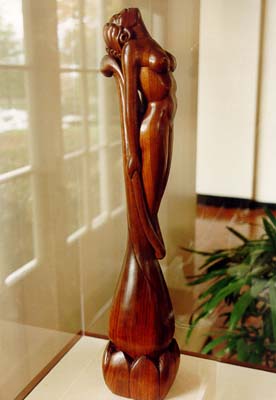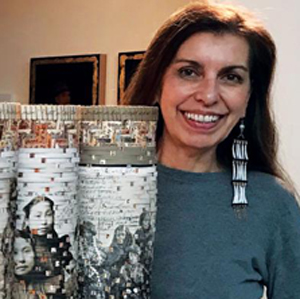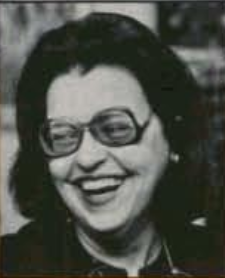Related Research Articles

Franklin Gritts, also known as Oau Nah Jusah, or "They Have Returned", was a Keetoowah Cherokee artist best known for his contributions to the "Golden Era" of Native American art, both as a teacher and an artist.

Martha Berry is a Cherokee beadwork artist, who has been highly influential in reviving traditional Cherokee and Southeastern beadwork, particularly techniques from the pre-Removal period. She has been recognized as a Cherokee National Treasure and is the recipient of the Seven Star Award and the Tradition Keeper Award. Her work is shown in museums around the United States.

Willard Stone was an American artist best known for his wood sculptures carved in a flowing Art Deco style.
Cecil Dick, or Degadoga (1915–1992) was a well-known Cherokee artist often referred to as "the Father of Cherokee Traditional Art".

Shan Goshorn was an Eastern Band Cherokee artist, who lived in Tulsa, Oklahoma. Her interdisciplinary artwork expresses human rights issues, especially those that affect Native American people today. Goshorn used different media to convey her message, including woven paper baskets, silversmithing, painting, and photography. She is best known for her baskets with Cherokee designs woven with archival paper reproductions of documents, maps, treaties, photographs and other materials that convey both the challenges and triumphs that Native Americans have experienced in the past and are still experiencing today.
Dana Tiger is a Muscogee artist of Seminole and Cherokee descent from Oklahoma. Her artwork focuses on portrayals of strong women. She uses art as a medium for activism and raising awareness. Tiger was inducted into the Oklahoma Women's Hall of Fame in 2001.
David Emmett Williams was a Native American painter, who was Kiowa/Tonkawa/Kiowa-Apache from Oklahoma. He studied with Dick West at Bacone College and won numerous national awards for his paintings. He painted in the Flatstyle technique that was taught at Bacone from the 1940s to the 1970s.

Norma Howard is a Choctaw-Chickasaw Native American artist from Stigler, Oklahoma, who paints genre scenes of children playing, women working in fields, and other images inspired by family stories and Choctaw life. Howard won her first art award at the 1995 Red Earth Native American Cultural Festival in Oklahoma City. Her work is popular with collectors and critics.
Doris Littrell (1929–2020) was a gallerist from central Oklahoma who promoted Native American art.
Bert Dail Seabourn was an American expressionist painter, known for his stylized and nonrepresentational neo-expressionist artist. In his early career, he published comic book art and realistic pieces, as well as commercial art. He has won multiple awards for his artworks. An alumnus of Oklahoma City University, the school awarded him the honorary degree of Doctor of Humane Letters in 1997.
Mel Cornshucker is a contemporary Cherokee potter living in Tulsa, Oklahoma, who works in stoneware, porcelain, and raku clay. Cornshucker is known for his high-fire stoneware, decorated with hand-painted, Native-inspired motifs and designs.
Merlin Little Thunder is a Southern Cheyenne artist living in Tulsa, Oklahoma. His paintings express the history, people and the land in a narrative, representational style, especially from the perspective of the Southern Cheyenne people. He is well known for his miniature paintings, bright colors, and for the incorporation of humor into his work.
Bill Rabbit was an Oklahoma Native artist who experimented with various styles, painting as he felt rather than according to public expectations. Rabbit exhibited his art in numerous locations and won many awards over the period of his artistic career. In 1986, he was designated Master Artist by the Five Civilized Tribes Museum. Toward the end of his life, Rabbit began collaborating on paintings with his daughter Traci, in their mutual studio located in Pryor, OK. On April 9, 2012, Rabbit died.
Donald Vann is a Cherokee artist from Oklahoma known for painting detailed landscapes with Native American subjects. Vann conveys the traditions and culture of his tribe through soft lines and colors. He has exhibited his work throughout the U.S. and abroad, winning numerous awards for his mystical paintings.
Rance Hood is an Oklahoma Native artist who echoes traditional Native American culture in his paintings. A self-taught artist, Hood was raised by his maternal grandparents who exposed him to Comanche Indian ways and values.

Valjean McCarty Hessing was a Choctaw painter, who worked in the Bacone flatstyle. Throughout her career, she won 9- awards for her work and was designated a Master Artist by the Five Civilized Tribes Museum in 1976. Her artworks are in collections of the Heard Museum of Phoenix, Arizona; the Philbrook Museum of Art in Tulsa, Oklahoma; the Southern Plains Indian Museum in Anadarko, Oklahoma; and the Wheelwright Museum of the American Indian of Santa Fe, New Mexico, among others.
Mary Adair is a Cherokee Nation educator and painter based in Oklahoma.
Robert McMurtry (1950–2012) was a painter and writer from Oklahoma who published several books for young adults about Native Americans in the United States and Oklahoma history.
Gary Montgomery is a professional artist of Seminole descent who primarily works with oil paints. An artist since the 1970s, Montgomery has established a reputation as a skilled Native artist. His work has been included in many exhibitions at the Five Civilized Tribes Museum in Muskogee, Oklahoma and numerous galleries in Oklahoma City. The Gilcrease Museum acquired his painting “Grizzly Bear with Reflection in Water” in 2006.
Bill Glass Jr. is a Cherokee Nation ceramic artist, sculptor, and public artist, who was named a Cherokee National Treasure in 2009.
References
- 1 2 "Robert Lee Taylor". askArt. Retrieved 10 May 2022.
- ↑ "Doris: She Walks With the Nations". National Museum of the American Indian. Retrieved 10 May 2022.
- ↑ Pearson Little-Thunder, Julie (September 15, 2010). "Oral history interview with Robert Taylor". Oklahoma Native Artists. Retrieved 23 July 2020.
- 1 2 Pearson, Julie. "Robert Taylor". Southwest Art. Retrieved 17 August 2015.
- ↑ "Robert Taylor". Pierson Gallery. Retrieved 17 August 2015.
- 1 2 "Taylor, Robert". Native Arts of America. Retrieved 17 August 2015.
- ↑ Skeen, Kelly. "Week Eight: Robert Taylor". WordPress. Retrieved 17 August 2015.